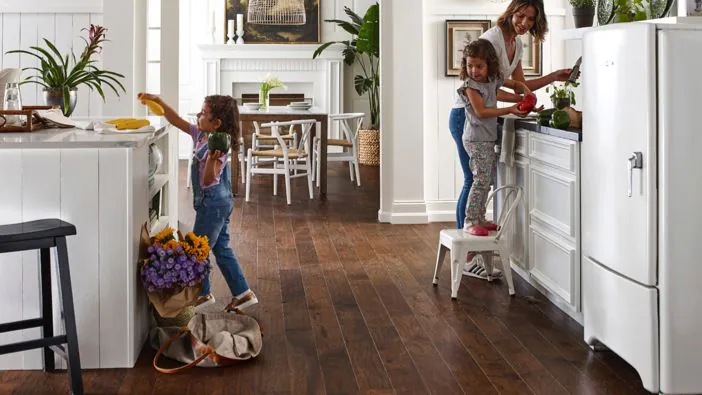Flooring is one of the key design components in a home, and must be chosen carefully to fit each room’s style and function.
Kitchens should feature moisture-resistant floors such as tile or vinyl; in living rooms, however, something warm underfoot such as hardwood is ideal.
Laminate
Laminate flooring is a synthetic product designed to mimic the appearance of real wood. Constructed by pressing and fusing multiple layers together with an image layer atop, laminate is then coated in clear resin for durability.
Aluminium laminate is highly durable and resistant to stains, moisture damage and scratches – ideal for high traffic areas in homes with pets and children. Although not as natural-looking as hardwood flooring, its convincing appearance allows you to replicate exotic species of wood with ease.
Laminate flooring is relatively affordable and easy to install on structurally sound subfloors using tongue-and-groove or modified click-and-lock system, taking just one weekend as a DIY project. Although laminate can withstand liquid spills without damage, moisture-resistant varieties may cost more. Unfortunately it cannot be refinished like hardwood does or add value to your home.
Linoleum
Linoleum stands apart from vinyl by being composed of renewable natural materials such as linseed oil, cork dust and wood flour; making it hypoallergenic, insulating and antimicrobial. When properly cared for and maintained it can last over 40 years with proper installation techniques; its easy installation makes avoiding scratches effortless while its biodegradability allows linseed oil component naturally breakdown in the environment.
Some homeowners frequently mistake the terms “linoleum” and “Marmoleum” as interchangeable, when in reality there are significant distinctions. While Marmoleum is an inexpensive brand-name type of linoleum that comes in various colors and patterns, traditional linoleum still remains viable option that can be inlaid into solid pieces or printed onto a jute or canvas backing for use in high foot traffic areas that may also be exposed to moisture – as well as being much more affordable than other flooring choices!
Vinyl
Vinyl is an economical, water resistant flooring material popularly used in homes today. This versatile material provides endless design possibilities. Resistant to scrapes, scuffs and stains as well as mildew and mold growth makes vinyl an excellent option for high traffic areas such as entryways. Furthermore, its water resistance makes it suitable for areas such as laundry rooms and bathrooms.
Vinyl flooring is widely considered an economical way to emulate other materials and styles such as wood planks or marble tiles. Available as planks, sheets and tiles – advances in industry have produced numerous design options available today.
vinyl can emit volatile organic compounds (VOCs), which have health ramifications such as ozone depletion, respiratory irritation and eye damage. Therefore it’s essential that any product selected has minimal VOC emissions; the good news is it’s easy to keep clean with routinely sweeping and mopping!
Sustainable Flooring
Sustainable flooring materials tend to be made from renewable resources that have less of an environmental impact than their counterparts, such as hardwood that has been certified FSC, wool carpet sourced from ethically raised sheep, cork harvested without harming trees, or tile made from recycled materials.
Many eco-friendly flooring options are more durable and require less maintenance, helping reduce indoor air pollution while protecting health problems like allergies and asthma.
Sustainable floors also boast natural insulating properties that can help regulate temperature in your home, potentially saving on energy costs. Furthermore, their versatility means they can complement any design style – from rustic wood and bamboo flooring to the earthy tones of cork – providing eco-friendly options that suit every aesthetic taste and design aesthetic.

